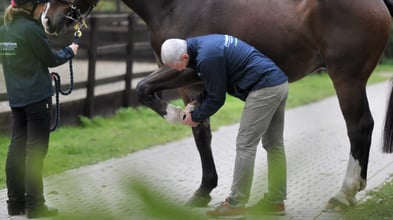Why Belgian vets are saying yes to objective gait analysis
Top Belgian equine veterinarians are clear: Objective gait analysis is becoming as essential as X-rays.

Longeing is commonly used during lameness and pre-purchase evaluations as it can amplify the degree of apparent lameness compared to a straight line trot. However, visual assessment of lameness while horses are trotting on a circle is difficult, as shown by the low inter-rater agreement among veterinarians evaluating lameness from videos of horses on the circle [1].
Certain patterns of movement asymmetry are recognized as normal during longeing, based on studies of horses with symmetrical movement during straight-line assessments [2]. However, distinguishing these circle-induced asymmetries in sound horses from asymmetries caused by pain in lame horses is challenging, and this difficulty could partly explain the low inter-rater agreement. In the study comparing the agreement of visual lameness evaluations of horses during longeing, the inter-rater agreement was lowest for classifying the horse as sound, with a kappa value of 0.08, where 1.0 signifies total agreement) [1].
A study of 94 horses with symmetrical movement on the straight found that the vertical head and pelvic movements during longeing were more asymmetric than during a straight-line trot. Common asymmetric patterns included more upward movement of the head during push-off of the outside forelimb (inside push-off) and less downward movement during the impact of the inside forelimb (outside impact) [2].
Currently, there are no definitive thresholds to distinguish normal circle-induced asymmetries from asymmetries seen in bilaterally lame horses, but the lamest limb is often visible during a straight line trot.
Common asymmetric patterns observed in the pelvis include less upward movement during the push-off of the outside hindlimb (outer push-off asymmetry) and less downward movement of the pelvis during the impact of the inside hindlimb, giving the impression of inner hind limb impact lameness. Asymmetric patterns in one longe direction were frequently not mirrored in the opposite direction (59% for the head and 54% for pelvis) [2]. Further research is needed to understand when the differences between directions signify pain and pathology and when it reflects biological variation as sidedness. The asymmetries caused by the circular movement can be affected by speed and circle radius. Therefore clinicians should aim to standardize speed and circle radius when evaluating horses on the longe before and after diagnostic analgesia [3].
When longeing horses with symmetrical movement on the straight, the symmetry of their movement doesn’t appear to be influenced by the surface. However, a hard surface can amplify forelimb-related asymmetries, particularly when the presumed affected forelimb is on the inside of the circle [4]. More research is needed to determine how the surface affects horses with different pathologies.
In a study on induced lameness (sole pressure), a hindlimb impact lameness (PDmin) was most pronounced when the lame hindlimb was to the inside of the circle. Conversely, forelimb impact lameness (HDmin) was most pronounced with the lame forelimb to the outside of the circle [5]. The primary hind limb lameness induced a compensatory head movement, which mimicked an ipsilateral forelimb lameness of almost equal magnitude to the primary hind limb lameness [5]. This could contribute to the difficulty in correctly detecting hindlimb lameness. Further research on compensatory patterns in clinical cases is needed to fully understand the lameness adaptation strategies on the circle.
Furthermore, in a group of horses with motion asymmetries (HDmin and PDmin) of unknown origin, the asymmetry was highest when the affected hindlimb was to the inside of the circle and when the affected forelimb was to the outside of the circle [6]. Further research on clinical cases with known diagnoses, whether the severity of lameness increases or decreases with the lame limb to the inside or outside of the circle, is warranted. This information could provide additional insights in locating the painful stimulus, thereby aiding in the decision-making process on where to start blocking.
Both circle-dependent and compensatory movement mechanisms must be considered when evaluating lameness during longeing.
— Dr. Marie Rhodin, DVM, DECVSMR and associate professor
-------------------------------------------------------------------------------------------------------------------
[1] Hammarberg M, Egenvall A, Pfau T, Rhodin M. Rater agreement of visual lameness assessment in horses during lungeing. Equine Vet J. 2016;48(1):78–82. https://beva.onlinelibrary.wiley.com/doi/full/10.1111/evj.12385
[2] Rhodin M., Roepstorff L., French A., Keegan K., Pfau T. Egenvall A. (2016) Head and pelvic movement asymmetry during lungeing in horses with symmetrical movement on the straight. Equine Veterinary journal, 48(3):315-20. https://pubmed.ncbi.nlm.nih.gov/25808700/
[3] Pfau, T., Stubbs, N.C., Kaiser, L.J., Brown, L.E. and Clayton, H.M. (2012) Effect of trotting speed and circle radius on movement symmetry in horses during lunging on a soft surface. Am. J. Vet. Res. 73, 1890-1899. https://pubmed.ncbi.nlm.nih.gov/23176414/
[4] Pfau T., Jennings,C., Mitchell H., Olsen E., Walker A., Egenvall A., Tröster S., Weller R., Rhodin M. (2016) Lungeing on hard and soft surfaces: Movement symmetry of trotting horses considered sound by their owners. Equine Vet. J. Jan;48(1):83-9. https://pubmed.ncbi.nlm.nih.gov/25297461/
[5] Rhodin M, Pfau T, Roepstorff L, Egenvall A.(2013). Effect of lungeing on head and pelvic movement asymmetry in horses with induced lameness. Vet J. . 2013 Dec;198 Suppl 1:e39-45. https://pubmed.ncbi.nlm.nih.gov/24140227/
[6] Rhodin M, Egenvall A, Andersen PH, Pfau T. Head and pelvic movement asymmetries at trot in riding horses in training and perceived as free from lameness by the owner. PLoS One. 2017;12(4):1–16. https://doi.org/10.1371/journal.pone.0176253

Top Belgian equine veterinarians are clear: Objective gait analysis is becoming as essential as X-rays.

Giorgio Ricardi of Donnington Grove Equine Vets reveals how data-driven gait analysis enhances clinical decisions in complex lameness cases.

We sat down with UK Master Farrier Marc Jerram, who blends traditional skill with modern gait analysis to spot issues early and collaborate with vets on targeted solutions.